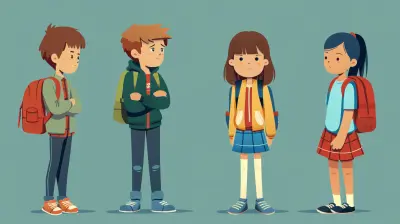How Graphic Organizers Can Enhance Reading Comprehension
11 August 2025
Reading comprehension is the key to unlocking knowledge. But let’s be honest—sometimes, figuring out what a passage really means can feel like trying to untangle a ball of yarn. That’s where graphic organizers come in! They act like roadmaps for your thoughts, making it easier to break down complex ideas, spot key details, and truly understand what you're reading.
Whether you're a student, a teacher, or just someone trying to improve your reading skills, graphic organizers can be game-changers. Let’s dive into how these tools work and why they’re so effective! 
What Are Graphic Organizers?
Simply put, graphic organizers are visual tools that help structure information. They can be charts, diagrams, or maps that allow readers to organize their thoughts and make sense of what they read. Think of them as a cheat sheet for your brain—they simplify complex content and help you retain information better.These tools come in handy for all kinds of reading materials, whether it's a history textbook, a novel, or a scientific article. By visually mapping out important details, they help readers grasp concepts without feeling overwhelmed. 
Why Reading Comprehension Matters
Before we jump into how graphic organizers help, let’s talk about why reading comprehension is so crucial. It’s not just about reading words on a page—it’s about truly understanding and engaging with the text. Strong comprehension skills allow you to:✅ Grasp key ideas and themes
✅ Make connections between different concepts
✅ Retain information for longer
✅ Think critically about what you're reading
✅ Apply knowledge in real-life situations
Without good comprehension, reading becomes a frustrating experience. But with the right tools, like graphic organizers, understanding content becomes much easier and even enjoyable. 
The Science Behind Graphic Organizers
Ever heard the saying, “A picture is worth a thousand words”? That’s exactly why graphic organizers work so well. Our brains process visual information much faster than text. When you use a graphic organizer, you're combining words with images, making it easier for your brain to store and retrieve information later.Studies have shown that students who use graphic organizers perform better in reading comprehension tests. Why? Because these tools help break down information into digestible chunks, reducing cognitive overload. 
Types of Graphic Organizers for Reading Comprehension
Graphic organizers come in all shapes and sizes, each serving a unique purpose. Let’s check out some of the most effective ones:1. Story Maps
Perfect for fiction reading, story maps help break down the structure of a story. They outline key elements like:📍 Setting – Where and when the story takes place
📍 Characters – The people (or animals!) involved
📍 Plot – The sequence of events
📍 Conflict – The main problem in the story
📍 Resolution – How the story wraps up
Using a story map helps readers see the bigger picture and understand character motivations and plot development.
2. Venn Diagrams
Venn diagrams are fantastic for comparing and contrasting two things. Whether you're analyzing two characters, events, or ideas, Venn diagrams make it easy to spot similarities and differences.For example, if you're reading about two historical figures, a Venn diagram helps you see what they had in common and what set them apart.
3. KWL Charts (Know, Want to Know, Learned)
KWL charts are great for active reading. They encourage curiosity and reflection by breaking down information into three sections:🔹 K (Know): What do you already know about the topic?
🔹 W (Want to Know): What questions do you have before reading?
🔹 L (Learned): What did you learn after reading?
This method keeps readers engaged and makes learning more meaningful.
4. Cause and Effect Charts
Many nonfiction texts discuss causes and effects, whether it’s about climate change, historical events, or scientific discoveries. This type of chart helps readers visualize the relationship between actions and their consequences, making the information easier to digest.5. Main Idea and Supporting Details Chart
Ever struggled to pick out the main idea in a passage? A main idea and details chart breaks it down clearly. It helps readers identify the most important point and the supporting evidence that backs it up.By using this tool, you can avoid getting lost in unnecessary details and focus on what really matters.
6. Sequence Charts (Flowcharts and Timelines)
If you're reading something with a specific order—like historical events, scientific processes, or step-by-step instructions—a sequence chart is a lifesaver. It visually maps out steps in a logical order, preventing confusion and making recall much easier.How Graphic Organizers Improve Reading Comprehension
Now that we know about different types of graphic organizers, let’s explore the actual benefits they bring to reading comprehension:🔹 1. Breaking Down Complex Information
Long paragraphs filled with heavy details can feel overwhelming. Graphic organizers simplify this information by categorizing and presenting it in a structured way.🔹 2. Enhancing Retention and Recall
Visual representation makes it easier for the brain to store information. When you connect words with images, you're more likely to remember key details later.🔹 3. Encouraging Active Learning
Instead of passively reading, graphic organizers require engagement. They force readers to think critically, make connections, and organize their thoughts.🔹 4. Improving Focus and Organization
It’s easy to get lost in a lengthy article or book. Graphic organizers keep things structured, making it easier to follow along without losing track of important details.🔹 5. Boosting Critical Thinking Skills
Graphic organizers help readers analyze information, compare perspectives, and draw conclusions. This is especially useful for developing strong problem-solving skills.How to Use Graphic Organizers Effectively
Alright, so we know graphic organizers are awesome, but how can you make the most of them? Here are some quick tips:✅ Pick the Right Organizer – Choose the one that best fits your reading material. For a novel? Use a story map. Reading an article? Try a main idea chart.
✅ Keep It Simple – Don’t overcomplicate things. Keep your organizer clear and to the point.
✅ Use Color and Symbols – Highlighting key details with colors or symbols boosts memory retention.
✅ Make It Interactive – If you're a teacher, encourage students to fill out organizers together to spark discussion.
✅ Review and Reflect – After using a graphic organizer, take a step back and review the information. This helps reinforce what you've learned.
Final Thoughts
Reading comprehension doesn’t have to be a struggle. With graphic organizers, you’re giving your brain the tools it needs to break down, understand, and retain information effortlessly. Whether you’re a student trying to ace an exam or just someone who loves diving into a good book, these visual aids can make all the difference.So, why not give them a shot? Grab a pen, draw out a simple chart, and see how much easier reading comprehension can be. You might just surprise yourself with how much more you understand!
all images in this post were generated using AI tools
Category:
Reading ComprehensionAuthor:

Anita Harmon
Discussion
rate this article
1 comments
Jennifer Duffy
Graphic organizers are game changers! They transform abstract concepts into clear visuals, making comprehension effortless. With these tools, students actively engage with texts, analyze information, and retain knowledge effectively. Don’t underestimate their power—implement them in your classroom and watch reading skills soar. It's time to revolutionize learning!
September 8, 2025 at 4:21 AM

Anita Harmon
Absolutely! Graphic organizers are essential tools that not only simplify complex ideas but also enhance student engagement and retention. Their transformative power in the classroom is undeniable!


